29 August 2023: Clinical Research
Effects of the Fourth Ventricle Compression Technique and Rib Raising Osteopathic Technique on Autonomic Nervous System Activity Measured by Heart Rate Variability in 35 Healthy Individuals
Jakub StępnikDOI: 10.12659/MSM.941167
Med Sci Monit 2023; 29:e941167
Abstract
BACKGROUND: Fourth ventricle compression (CV4) is a cranial osteopathic manipulation technique for brain and cranial nerve function. Rib raising is an osteopathic technique that reduces rib restriction and conditions associated with sympathetic hypertonia. This study aimed to evaluate the effects of the CV4 and rib raising osteopathic techniques on autonomic nervous system activity, measured by heart rate variability, in 35 healthy individuals.
MATERIAL AND METHODS: The study involved 35 healthy participants, randomly divided into 2 groups. The experimental group received osteopathic therapy in the form CV4 and rib raising techniques for 30 min. The placebo group had a sham procedure performed using an ultrasound transducer for 20 min. The test of heart rate variability was conducted for 6 min, with participants in a seated position.
RESULTS: A significant decrease in heart rate values was observed in the experimental group (P=0.012), and an increase in the standard deviation of all the rib raising intervals parameter and a decrease in the high frequency% parameter was observed in the placebo group (P=0.035, P=0.048; respectively). There were no differences in other parameters between the groups.
CONCLUSIONS: The use of the CV4 technique and rib raising technique leads to a significant decrease in heart rate, which can be interpreted as increased parasympathetic activity; however, the use of these techniques did not affect the other parameters.
Keywords: Manipulation, Osteopathic, Osteopathic Medicine, Heart Rate, Heart Rate Determination, Musculoskeletal Manipulations, Humans, Autonomic Nervous System, Brain, Fourth Ventricle, Ribs
Background
A decrease in parasympathetic activity, which is responsible for regenerative functions, digestive functions, and inflammation control, along with an increase in sympathetic activity is associated with the fight-or-flight response. The decrease in parasympathetic activity and increase in sympathetic activity can result in sleep disorders, disruption of brain bioelectrical function, and a reduced ability to generate theta waves. It can also significantly impact the functions of the glymphatic-lymphatic continuum, which is responsible for clearing the central nervous system of medium and large protein molecules and toxins [1,2]. Ultimately, this can increase the risk of developing neurodegenerative diseases, such as Parkinson disease, Alzheimer disease, and multiple sclerosis [1–5]. Notably, the risk of developing Alzheimer disease after the age of 50 is 50% in this group of patients [6].
In addition, Xie et al (2013) found that sympathetic arousal reduces brain interstitial fluid volume and central nervous system detoxification efficiency by more than 60%, which can consequently lead to chronic dysautonomia [7].
Therefore, it seems that early detection of symptoms of dysautonomia (increased sympathetic nervous system excitation and decreased parasympathetic nervous system excitation) and the search for effective evidence-based therapeutic interventions can make a significant contribution to inhibiting or reducing the symptoms of conditions underlying neurodegenerative changes [7].
There is no consensus in the literature as to whether the use of osteopathic techniques in the form of high velocity low amplitude manipulations performed on the cervical and thoracic parts of the spine, techniques aimed at the cranial field, or the use of rib raising techniques produce a significant effect on autonomic nervous system function [8–13]. Some of the studies conducted confirm the effectiveness of osteopathic techniques in normalizing autonomic nervous system function [9–12], while others have shown no such effect [8,13].
Given the divergent opinions on the effectiveness of osteopathic techniques, as well as their increasingly widespread use, the main objective of this study was to verify the effect of osteopathic techniques on autonomic nervous system function, as expressed by heart rate variability (HRV). HRV is a measurement of the variations in the time intervals between consecutive heartbeats. It provides insights into the functioning of the autonomic nervous system, which regulates the balance between the sympathetic and parasympathetic branches, known as the “fight-or-flight” and “rest-and-digest” responses, respectively. HRV is widely used as a noninvasive and objective tool for assessing autonomic nervous system activity and its modulation [10,14,15].
Therefore, this study aimed to evaluate the effects of the fourth ventricle compression technique (CV4) and rib raising osteopathic technique on autonomic nervous system activity measured by HRV in 35 healthy individuals. The participants voluntarily consented to participate in the study and were informed about its methodology and purpose.
HRV parameters refer to various quantitative measures derived from the analysis of HRV. These parameters provide insights into the dynamics and modulation of the heart’s autonomic nervous system activity. Some commonly used HRV parameters are time-domain parameters, frequency-domain parameters, and nonlinear parameters [16].
These 3 parameters provide valuable information about the autonomic nervous system’s influence on heart rhythm and are widely used in research and clinical settings to assess autonomic function, cardiovascular health, and stress levels.
Material and Methods
ETHICS STATEMENT:
The local Ethical Committee granted permission for this research (permission number: 2/2016).
After reviewing the documentation related to the research project mentioned above, the Senate Committee on Ethics of Scientific Research concluded that it did not find any elements in the project that were inconsistent with the principles of ethical conduct of research involving humans.
The Committee acknowledged the following:
STUDY POPULATION:
Inclusion criteria for the study were age 24 to 60 years and participants not currently receiving any form of rehabilitation, physiotherapy, or osteopathy.
Exclusion criteria for the study were as follows: unstable arrhythmia in the patient’s history and symptoms related to chest organs (retrosternal pain, difficulty breathing) [17], pregnancy [17], symptoms suggestive of disorders related to bowel obstruction (bloating with pain, vomiting, diarrhea) [17], smoking [13], surgical treatment in the head [13], neurological diseases [13], menstruation [8], having had physiotherapy or osteopathy treatment within the last month, regardless of the reason [8], back and peripheral joint pain, and trauma and musculoskeletal dysfunction in the last 12 months.
A total of 36 healthy volunteers met the above-mentioned criteria. Next, the study group was randomly divided into an experimental group and a placebo group.
RANDOMIZATION:
Thirty-six participants drew cards from a specially prepared box containing either the letter E, indicating the experimental group, or the letter P, indicating the placebo group. After drawing their card, participants reported their result to the person preparing the cards, who recorded their data and assigned them to a group. All participants signed consent forms and were given detailed documents describing the study, indications, and contraindications. None of the participants knew which group they were assigned to. The person conducting post-therapy measurements was also blinded to participants’ group assignment.
Finally, the experimental group included 17 participants (1 participant resigned from the study), while the placebo group included 18 participants. Characteristics of the participants are presented in Table 1.
INTERVENTION IN THE EXPERIMENTAL GROUP:
Intervention applied in the experimental group was performed with the use of 2 techniques: (1) CV4 and (2) rib raising, which are oriented toward normalizing autonomic nervous system by lowering the heart’s contraction rate [8,18].
The CV4 procedure is a well-known technique in the field of osteopathy. In the CV4 technique, the patient lies down, and the therapist holds the squamous part of the occipital bone, specifically its lateral angles, while manipulating the cranium into extension. The therapist maintains the extension of the cranium and waits for a motionless state. Once the cranial pulse becomes apparent, the therapist can conclude the procedure [15] (Figures 1, 2). The entire procedure lasted 30 min, and its methodology was selected based on recommendations from the literature [13]. According to the assumptions, the technique aims to stimulate the parasympathetic nervous system by affecting the vagus nerve and improving the brain’s glymphatic system [9].
For the rib raising technique, the participant was in a supine position on a therapy table. The therapist was in a sitting position on the participant’s left side. The therapist’s phalanges were placed near the angles of the ribs and applied pressure in the abdominal and lateral directions so that there was movement in the costovertebral joint. The pressure and the pause in its execution lasted for 5 s each. The technique was started from ribs I–IV (Figures 3, 4). After 10 cycles (pressure-break), the technique was performed on ribs V–VIII (10 cycles), followed by ribs IX–XII (10 cycles). After the entire procedure was performed 3 times on the left side, it was repeated on the right side for 3 times. The entire procedure for both sides took about 30 min. Its methodology was selected based on recommendations from the literature [11]. According to the guidelines, the technique aims to mobilize the costovertebral joint, through which it should affect the local metabolism of autonomic sympathetic ganglia and inhibit the activity of the sympathetic nervous system [11]. Osteopathic diagnosis of the ribs can assist in distinguishing between rib somatic dysfunction and referred pain originating from thoracic viscera. This differentiation is crucial for accurate diagnosis and effective management options. Previous studies have shown that osteopathic manipulative treatment is effective in alleviating pain and improving thoracic motion in patients with conditions such as costochondritis, costovertebral joint dysfunction, and post-sternotomy rib dysfunction. These findings highlight the potential benefits of osteopathic manipulative treatment in providing relief and improving function in patients with rib-related issues [19]. The rib raising technique aims to reduce rib restriction and address conditions associated with sympathetic hypertonia. This technique has been used to improve thoracic motion and relieve pain in various rib-related dysfunctions [19].
PLACEBO INTERVENTION IN THE CONTROL GROUP:
For the sham therapeutic technique, the participant was in a prone position on the therapy table. The examiner moved the ultrasound transducer in the thoracic region of the spine in an area 10 cm from the level of the spinous processes on both sides and in the suboccipital region. Prior to the procedure, the participant was informed that, using the ultrasound probe, the therapist would look for areas with increased tissue tension, which would be “confirmed” by the red color on the ultrasound monitor. Tissue relaxation was mimicked by a color change to green. The total intervention time was 20 min (Figure 5).
The techniques were executed by an osteopath who has both osteopathic and physiotherapy qualifications and 14 years of clinical experience.
HRV STUDY PROTOCOL:
The HRV test was used to evaluate autonomic nervous system function [12,13,20]. For the study, an EEG/HRV/RSA Infiniti 8 measuring device, ProComp Infiniti encoder, and Biograph Infiniti and Physiology Suit software from Biomed Neurotechnologie were used (www.biomed.org.pl 01.06.2022) [21].
The test took place with the participant in a sitting position. Before the test, the participant was asked to sit in a chair for 5 min to calm down and get accustomed to the sitting position. After the procedure, the participant was also asked to sit for 5 min in a chair before the HRV test was conducted. The participants were instructed to breathe calmly in a way that was natural to them during the 6-min test. The participants were also asked to avoid moving the finger to which the measuring apparatus was connected. After the procedure, a certified physiotherapist for HRV testing processed the test result from artifacts.
STATISTICAL ANALYSIS:
The statistical analysis was conducted using Statistica 13.3 (StatSoft, Poland). The Shapiro-Wilk test was used for the assessment of the distribution of variables. Data are presented as mean and standard deviation for somatic parameters (age, weight, height, body mass index), and median, minimum, maximum, and first and third quartiles for parameters of heart rate (HR) variables (SBP, DBP, HR, HRV, SDRR, LF%, HF%, HRV LF/HF). The Wilcoxon signed-rank test was conducted to examine the differences in parameters of HR variables before and after the intervention. The Mann-Whitney U test was used to compare the groups before and after the intervention. The statistical significance was set at
The power of the test was calculated using G*Power 3.1.9.7 (Dusseldorf, Germany). The post-hoc power analysis for the t statistic of 2 dependent groups for HR values in the experimental group was 0.81 (n=35, M1=77.5, M2=73.2, SD1=10.5, SD2=8.8, ES=0.44).
Results
PRE-INTERVENTION GROUP COMPARISON:
Table 2 shows the SBP, DBP, and HRV parameters before the study in the experimental and placebo groups (Table 2). Before the study, no statistically significant differences were observed in the measured parameters between the groups.
PRE- AND POST-INTERVENTION COMPARISON OF RESULTS:
A significant decrease in HR values was observed in the experimental group (P=0.012), and significant changes in the parameter SDRR and HF% power mean were observed in the placebo group (P=0.035, P=0.048; respectively) (Table 3). However, it should be noted that the standard deviations of all the RR interval parameters is more suitable for 24-h measurements and may not be reliable for short-term measurements. The HF% parameter, which reflects vagus nerve tone, increased in the experimental group (from 29.43 to 36.40), although the change was not statistically significant.
POST-INTERVENTION RESULTS COMPARED BETWEEN GROUPS:
After the intervention, there were no differences between the experimental and placebo groups (Table 4). Although the largest change was observed in the HF% parameter between the experimental group (36.40%) and placebo group (23.14%), the difference was not statistically significant (P=0.111).
Discussion
LIMITATIONS OF THE STUDY:
One limitation of the study was the use of only 1 treatment session, which may have had insufficient stimulation needed to change parameters related to the autonomic nervous system. Another limitation was the treatment time, which may have been too short to affect the autonomic nervous system. However, the techniques used were based on recommendations from the literature [9–12], and therefore we concluded it was necessary to verify the therapeutic procedures as they are used in clinical practice and research. It is also worth noting that the level of participants’ physical activity was not considered. Therefore, in further studies, this factor should be included.
CLINICAL RELEVANCE OF THE STUDY:
The clinical value of the study was the use of techniques commonly used in clinical practice [9–12]. In addition, these techniques are often used in research studies, and the evaluation of their effects on the autonomic nervous system varies [8–13]. This study has shown that these techniques may have the slight effect of increasing parasympathetic nervous system activity. However, caution should be exercised in such an evaluation, owing to the fact that the observed changes involved only one of the parameters assessed (HR).
It is important to note that the HRV parameter we used in the study has limitations, as there are no established norms for each specific parameter. Additionally, it should be noted that our study was conducted on a small group of healthy individuals, and we observed only 1 indicator of autonomic activity (HR). Therefore, it would be valuable to conduct further research with a larger sample size and more specific analysis of autonomic nervous system indicators.
Conclusions
The application of the CV4 and rib raising techniques results in a noteworthy decrease in HR, indicating an increase in parasympathetic activity. Nonetheless, as most of the evaluated parameters were not affected, it is essential to conduct additional research to confirm the effects of osteopathic techniques on autonomic nervous system function.
There is a possibility that the combination of 2 techniques, instead of performing them separately, had a negative impact on the study results and did not affect the other parameters of HRV.
Figures
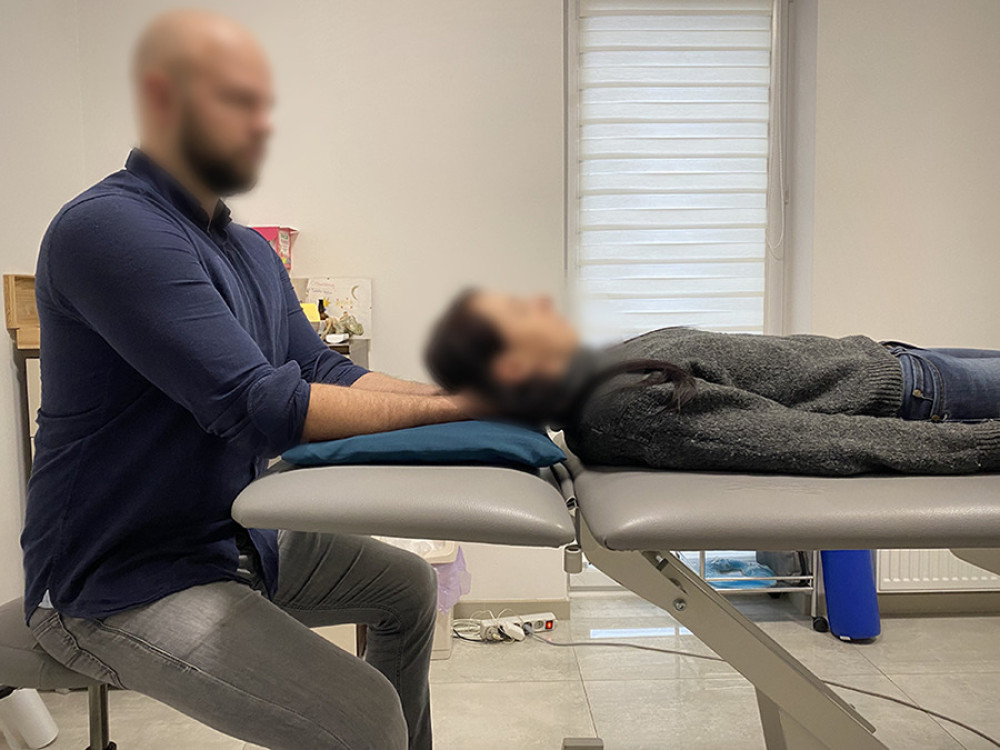 Figure 1. Position of the therapist and the patient during fourth ventricle compression technique.
Figure 1. Position of the therapist and the patient during fourth ventricle compression technique. 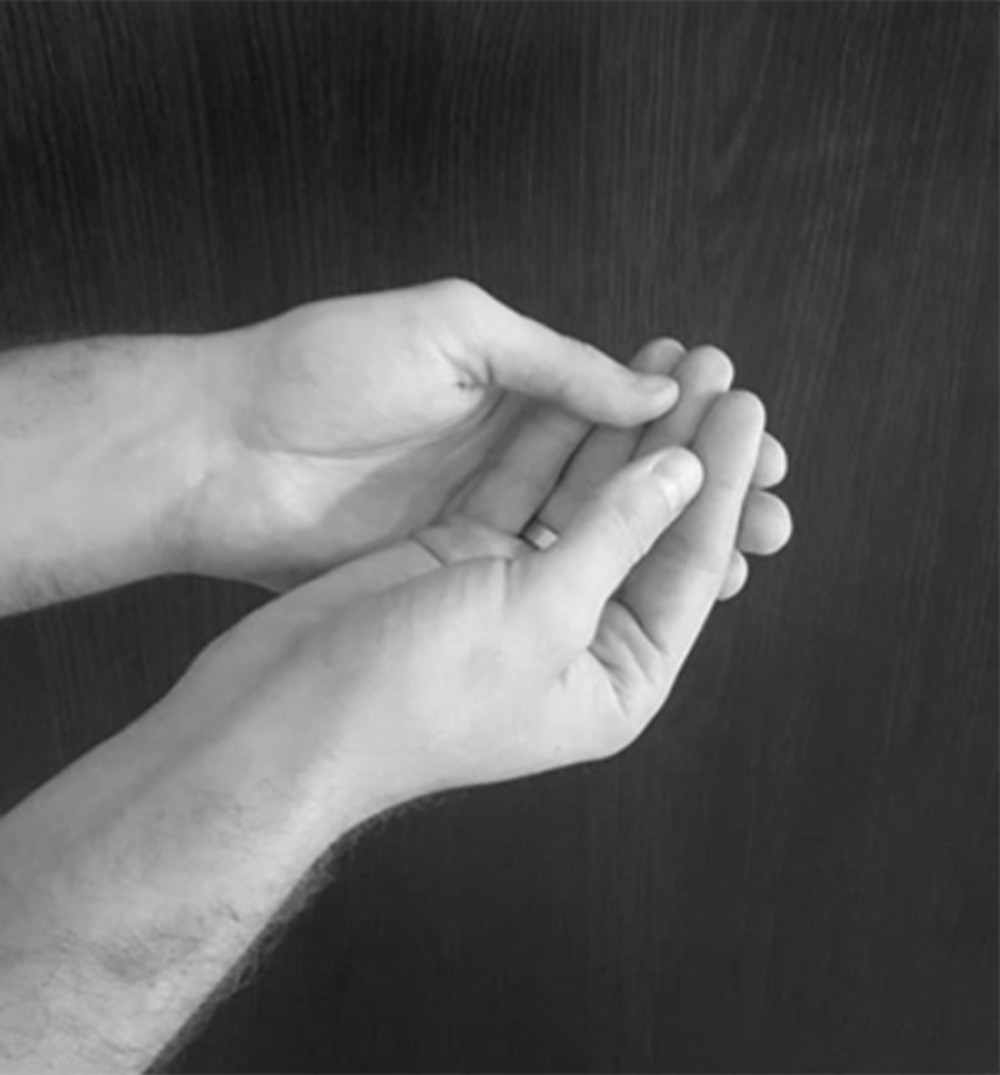 Figure 2. Alignment of the therapist’s hand during fourth ventricle compression technique.
Figure 2. Alignment of the therapist’s hand during fourth ventricle compression technique. 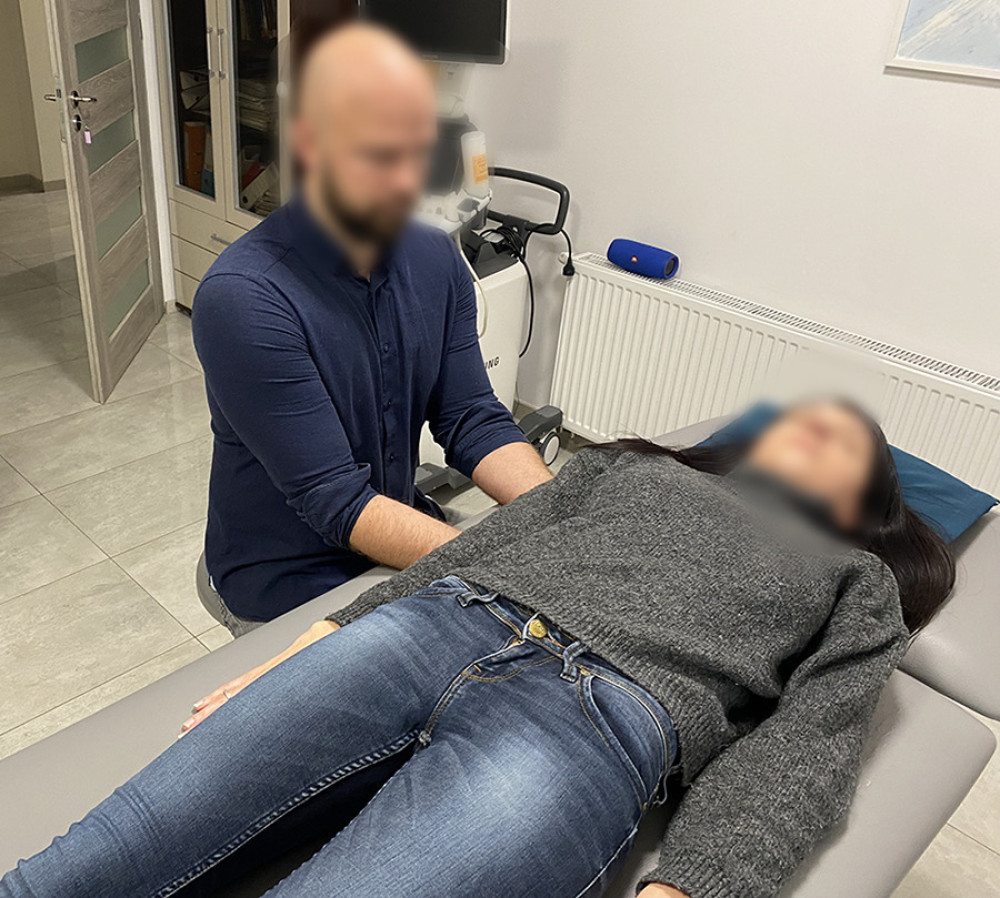 Figure 3. Position of the therapist and the patient during the rib raising technique.
Figure 3. Position of the therapist and the patient during the rib raising technique. 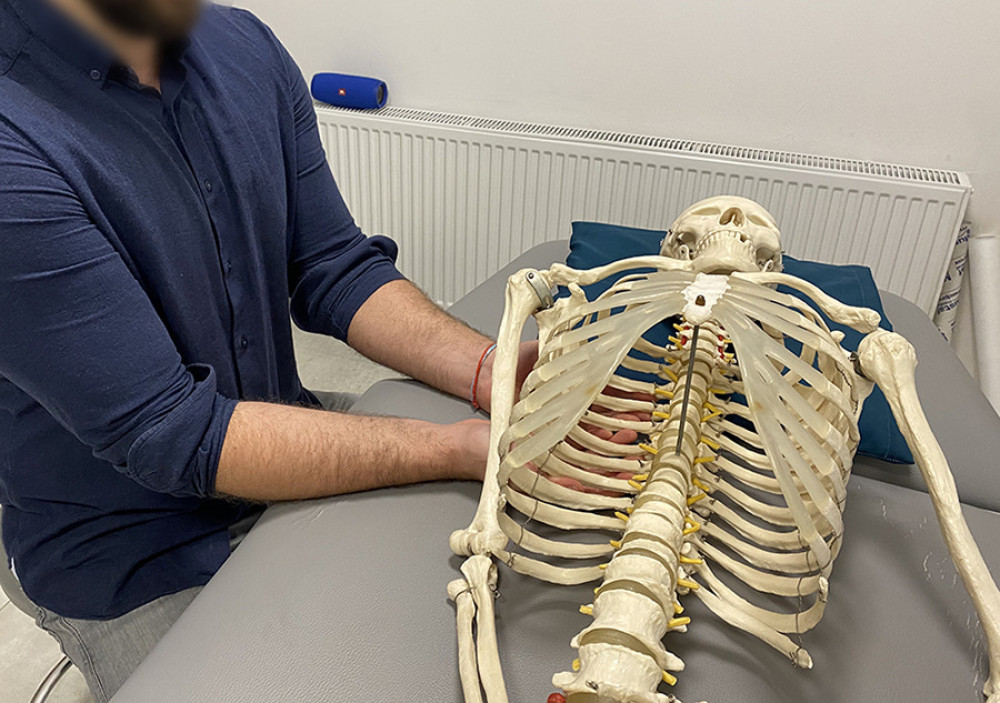 Figure 4. Position of the therapist’s hands during rib raising technique.
Figure 4. Position of the therapist’s hands during rib raising technique. 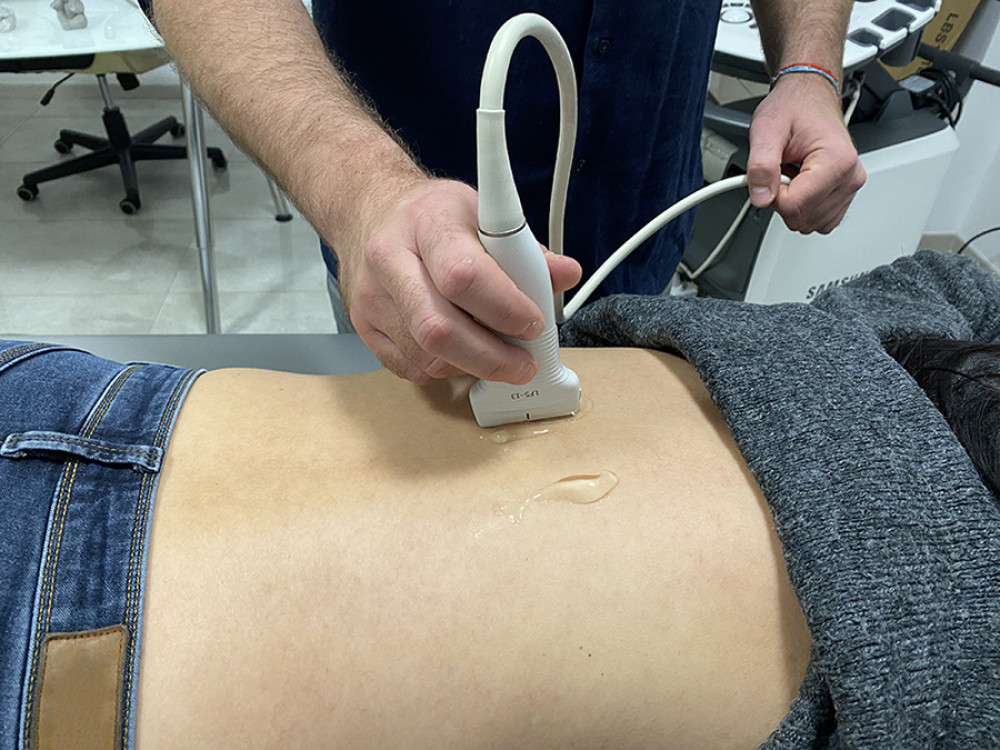 Figure 5. Sham therapeutic technique, using ultrasound on the patient’s back.
Figure 5. Sham therapeutic technique, using ultrasound on the patient’s back. Tables
Table 1. Characteristics of the study population.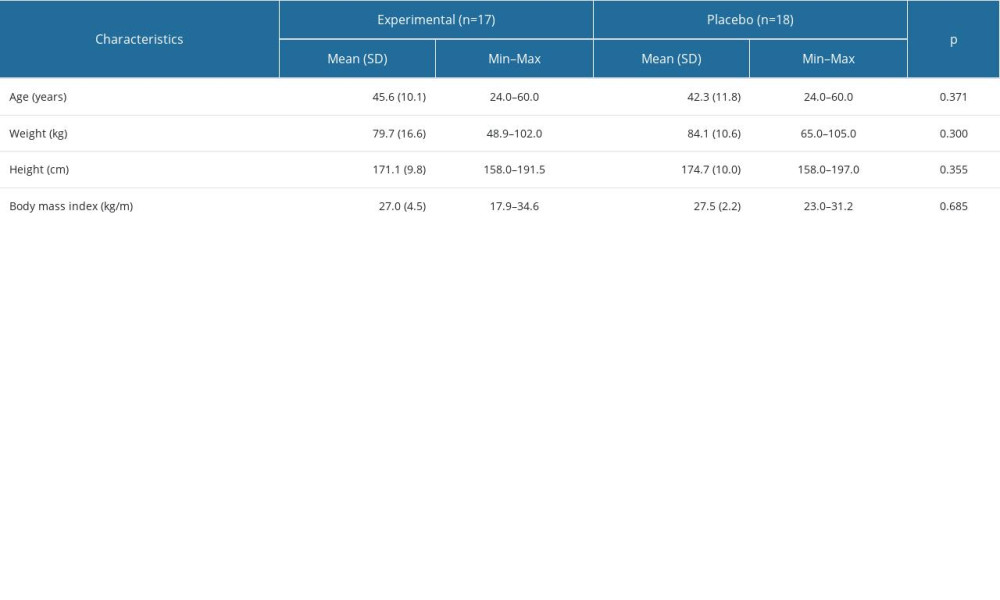 Table 2. The systolic and diastolic blood pressure and heart rate variability parameters in experimental and placebo groups before the intervention.
Table 2. The systolic and diastolic blood pressure and heart rate variability parameters in experimental and placebo groups before the intervention.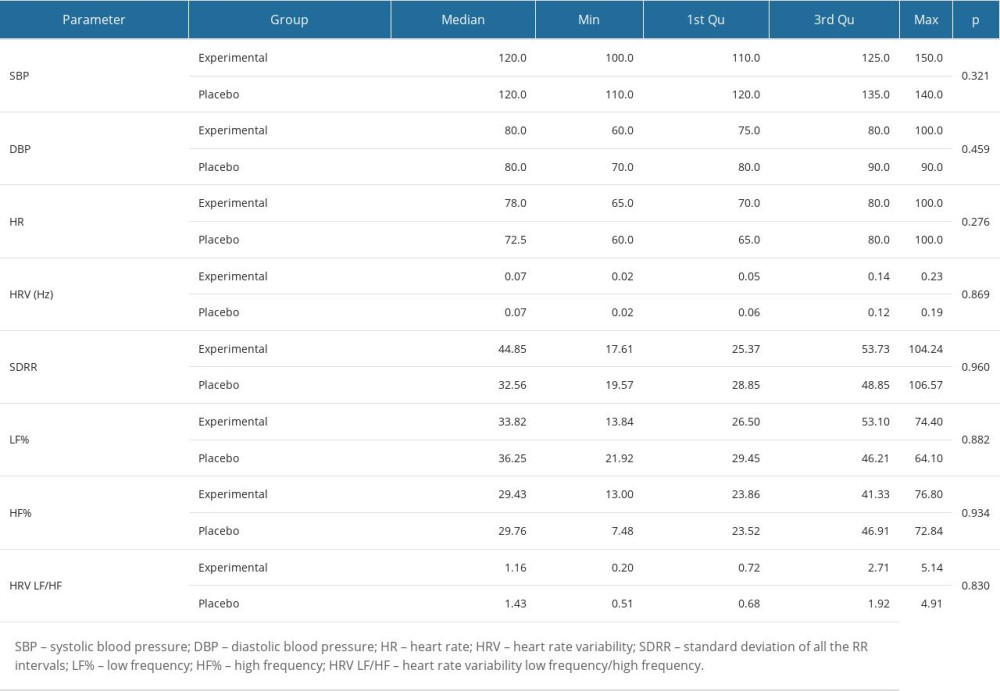 Table 3. Comparison of systolic and diastolic blood pressure and HRV parameters before and after intervention in the experimental and placebo groups.
Table 3. Comparison of systolic and diastolic blood pressure and HRV parameters before and after intervention in the experimental and placebo groups.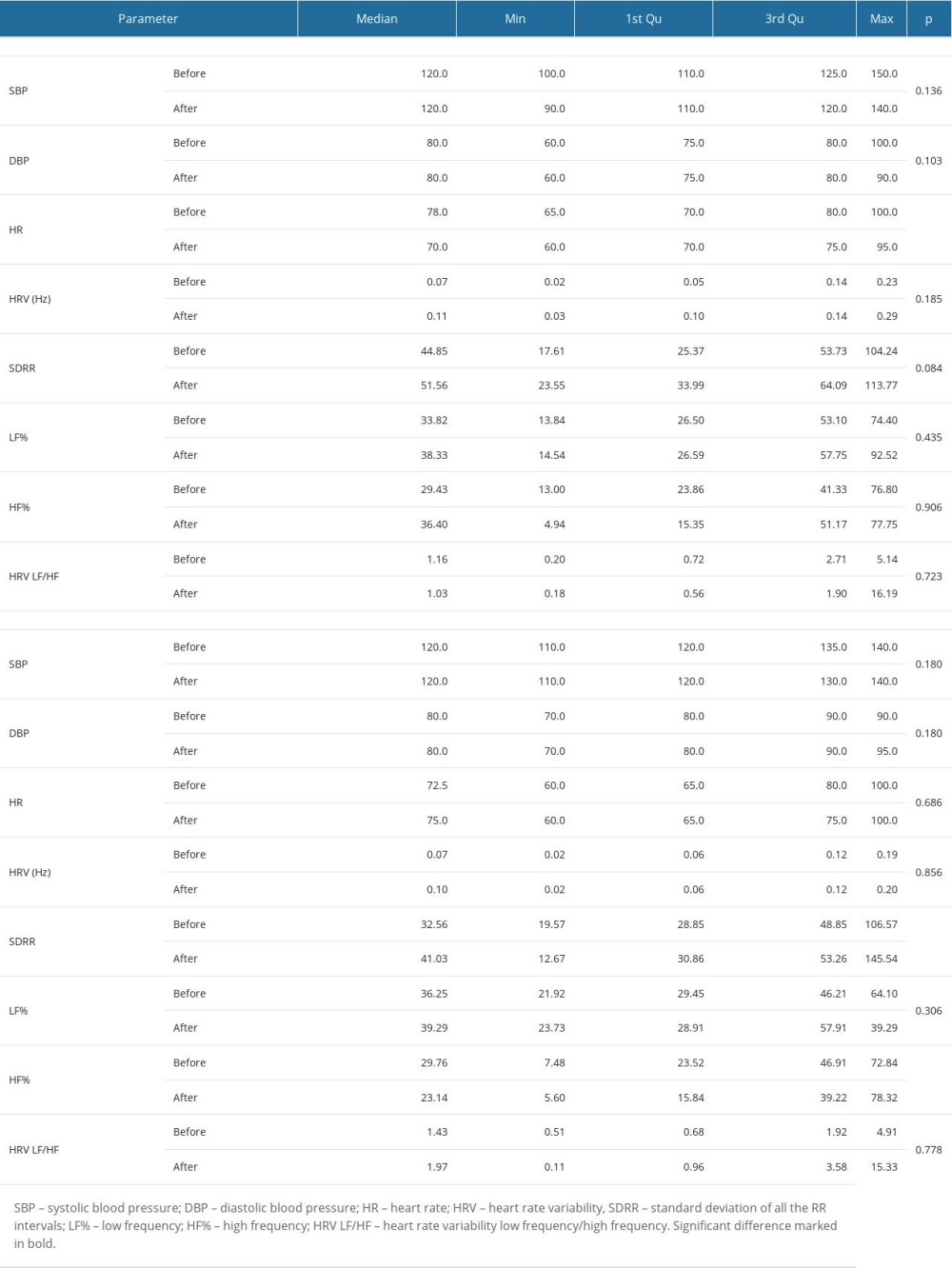 Table 4. Comparison of systolic and diastolic blood pressure and HRV parameters in experimental and placebo groups after intervention.
Table 4. Comparison of systolic and diastolic blood pressure and HRV parameters in experimental and placebo groups after intervention.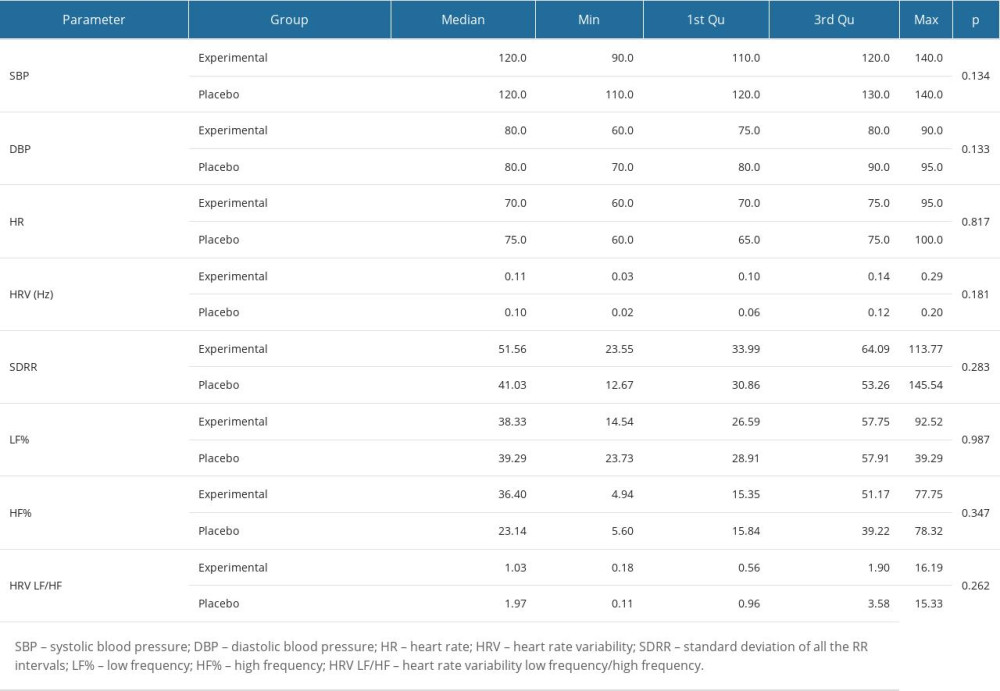
References
1. Hitscherich K, Smith K, Cuoco JA, The glymphatic-lymphatic continuum: Opportunities for osteopathic manipulative medicine: J Am Osteopath Assoc, 2016; 116(3); 170-77
2. Mendelsohn AR, Larrick JW, Sleep facilitates clearance of metabolites from the brain: Glymphatic function in aging and neurodegenerative diseases: Rejuvenation Res, 2013; 16(6); 518-23
3. Goldstein DS, Robertson D, Esler M, Straus SE, Dysautonomias: Clinical disorders of the autonomic nervous system: Ann Intern Med, 2002; 137; 753-63
4. Iliff J, Chen M, Plog B, Impairment of glymphatic pathway function promotes tau pathology after traumatic brain injury: J Neurosci, 2014; 34; 16180-93
5. Kress BT, Iliff JJ, Xia M, Impairment of paravascular clearance pathways in the aging brain: Ann Neurol, 2014; 76; 845-61
6. Tanzi RE, The genetics of Alzheimer disease: Cold Spring Harb Perspect Med, 2012; 2; a006296
7. Xie L, Kang H, Xu Q, Sleep drives metabolite clearance from the adult brain: Science, 2013; 342; 373-77
8. Cardoso AP, Rodríguez-Blanco C, Riquelme-Agulló I, Effects of the fourth ventricle compression in the regulation of the autonomic nervous system: A randomized control trial: Evid Based Complement Alternat Med, 2015; 2015; 1482851
9. Curi AC, Alves AS, Silva JG, Cardiac autonomic response after cranial technique of the fourth ventricle (cv4) compression in systemic hypertensive subjects: J Bodyw Mov Ther, 2017; 22; 666-72
10. Giles PD, Hensel K, Pacchia CF, Smith ML, Suboccipital decompression enhances heart rate variability indices of cardiac control in healthy subjects: J Altern Complement Med, 2013; 19(2); 92-96
11. Henderson AT, Fisher JF, Blair J, Effects of rib raising on the autonomic nervous system: J Am Osteopath Assoc, 2010; 110; 324-30
12. Mauro F, Single osteopathic manipulative therapy session dampens acute autonomic and neuroendocrine responses to mental stress in healthy male participants: J Am Osteopath Assoc, 2017; 117; 559-67
13. Milnes K, Moran RW, Physiological effects of a CV4 cranial osteopathic technique on autonomic nervous system function: A preliminary investigation: Int J Osteopath Med, 2007; 10(1); 8-17
14. Roy RA, Boucher JP, Comtois AS, Heart rate variability modulation after manipulation in pain-free patients vs patients in pain: J Manipul Physiol Ther, 2009; 32(4); 277-86
15. Żurowska A, Malak R, Kołcz-Trzęsicka A, Compression of the fourth ventricle using a craniosacral osteopathic technique: A systematic review of the clinical evidence: Evid Based Complement Alternat Med, 2017; 2017; 2974962
16. Przybysz-Zdunek B, Główczyńska R, Heart rate variability in practice – an appreciated or forgotten parameter of Holter assessment?: Folia Cardiol, 2017; 12(6); 617-24
17. Hebgen EU: Visceral manipulation in osteopathy, 2011; 5-224, Stuttgart, Georg Thieme Verlag
18. Chaitow L: Cranial manipulation, 2005; 283-85, DB Publishing
19. Koch J, Tsui C, Talsma J, Pierce-Talsma S, Osteopathic manipulative treatment for inhaled rib somatic dysfunction: J Osteopath Med, 2020; 120(10); 696-97
20. Stępnik J, Kędra A, Czaprowski D, Short-term effect of osteopathic manual techniques (OMT) on respiratory function in healthy individuals: PLoS One, 2020; 15(6); e0235308
21. : Course materials: Biomed neurotechnology’s – heart rate variability HRV/RS, 2021, Wrocław Available from: https://biomed.org.pl/
22. Shaffer F, Ginsberg JP, An overview of heart rate variability metrics and norm: Front Public Health, 2017; 5; 1-17
23. Arienti C, Farinola F, Ratti S, Variations of HRV and skin conductance reveal the influence of CV4 and Rib Raising techniques on autonomic balance: A randomized controlled clinical trial: J Bodyw Mov Ther, 2020; 24(4); 395-401
24. Abenavoli A, Badi F, Barbieri M, Cranial osteopathic treatment and stress-related effects on autonomic nervous system measured by salivary markers: A pilot study: J Bodyw Mov Ther, 2020; 4(24); 215-21
25. Amoroso Borges BL, Bortolazzo GL, Neto HP, Effects of spinal manipulation and myofascial techniques on heart rate variability: A systematic review: J Bodyw Mov Ther, 2018; 22(1); 203-8
Figures
 Figure 1. Position of the therapist and the patient during fourth ventricle compression technique.
Figure 1. Position of the therapist and the patient during fourth ventricle compression technique. Figure 2. Alignment of the therapist’s hand during fourth ventricle compression technique.
Figure 2. Alignment of the therapist’s hand during fourth ventricle compression technique. Figure 3. Position of the therapist and the patient during the rib raising technique.
Figure 3. Position of the therapist and the patient during the rib raising technique. Figure 4. Position of the therapist’s hands during rib raising technique.
Figure 4. Position of the therapist’s hands during rib raising technique. Figure 5. Sham therapeutic technique, using ultrasound on the patient’s back.
Figure 5. Sham therapeutic technique, using ultrasound on the patient’s back. Tables
 Table 1. Characteristics of the study population.
Table 1. Characteristics of the study population. Table 2. The systolic and diastolic blood pressure and heart rate variability parameters in experimental and placebo groups before the intervention.
Table 2. The systolic and diastolic blood pressure and heart rate variability parameters in experimental and placebo groups before the intervention. Table 3. Comparison of systolic and diastolic blood pressure and HRV parameters before and after intervention in the experimental and placebo groups.
Table 3. Comparison of systolic and diastolic blood pressure and HRV parameters before and after intervention in the experimental and placebo groups. Table 4. Comparison of systolic and diastolic blood pressure and HRV parameters in experimental and placebo groups after intervention.
Table 4. Comparison of systolic and diastolic blood pressure and HRV parameters in experimental and placebo groups after intervention. Table 1. Characteristics of the study population.
Table 1. Characteristics of the study population. Table 2. The systolic and diastolic blood pressure and heart rate variability parameters in experimental and placebo groups before the intervention.
Table 2. The systolic and diastolic blood pressure and heart rate variability parameters in experimental and placebo groups before the intervention. Table 3. Comparison of systolic and diastolic blood pressure and HRV parameters before and after intervention in the experimental and placebo groups.
Table 3. Comparison of systolic and diastolic blood pressure and HRV parameters before and after intervention in the experimental and placebo groups. Table 4. Comparison of systolic and diastolic blood pressure and HRV parameters in experimental and placebo groups after intervention.
Table 4. Comparison of systolic and diastolic blood pressure and HRV parameters in experimental and placebo groups after intervention. In Press
12 Mar 2024 : Clinical Research
Metabolomic Alterations in Methotrexate Treatment of Moderate-to-Severe PsoriasisMed Sci Monit In Press; DOI: 10.12659/MSM.943360
14 Mar 2024 : Clinical Research
Renal Dysfunction Increases Risk of Adverse Cardiovascular Events in 5-Year Follow-Up Study of Intermediate...Med Sci Monit In Press; DOI: 10.12659/MSM.943956
15 Mar 2024 : Clinical Research
Impact of One-Lung Ventilation on Oxygenation and Ventilation Time in Thoracoscopic Heart Surgery: A Compar...Med Sci Monit In Press; DOI: 10.12659/MSM.943089
14 Mar 2024 : Clinical Research
Differential DHA and EPA Levels in Women with Preterm and Term Births: A Tertiary Hospital Study in IndonesiaMed Sci Monit In Press; DOI: 10.12659/MSM.943895
Most Viewed Current Articles
17 Jan 2024 : Review article
Vaccination Guidelines for Pregnant Women: Addressing COVID-19 and the Omicron VariantDOI :10.12659/MSM.942799
Med Sci Monit 2024; 30:e942799
14 Dec 2022 : Clinical Research
Prevalence and Variability of Allergen-Specific Immunoglobulin E in Patients with Elevated Tryptase LevelsDOI :10.12659/MSM.937990
Med Sci Monit 2022; 28:e937990
16 May 2023 : Clinical Research
Electrophysiological Testing for an Auditory Processing Disorder and Reading Performance in 54 School Stude...DOI :10.12659/MSM.940387
Med Sci Monit 2023; 29:e940387
01 Jan 2022 : Editorial
Editorial: Current Status of Oral Antiviral Drug Treatments for SARS-CoV-2 Infection in Non-Hospitalized Pa...DOI :10.12659/MSM.935952
Med Sci Monit 2022; 28:e935952








